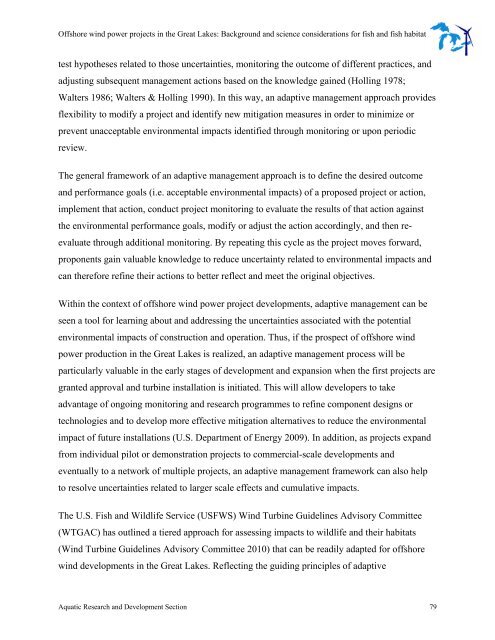Offshore Wind Power Projects in the Great Lakes - Ministry of ...
Offshore Wind Power Projects in the Great Lakes - Ministry of ...
Offshore Wind Power Projects in the Great Lakes - Ministry of ...
Create successful ePaper yourself
Turn your PDF publications into a flip-book with our unique Google optimized e-Paper software.
<strong>Offshore</strong> w<strong>in</strong>d power projects <strong>in</strong> <strong>the</strong> <strong>Great</strong> <strong>Lakes</strong>: Background and science considerations for fish and fish habitat<br />
test hypo<strong>the</strong>ses related to those uncerta<strong>in</strong>ties, monitor<strong>in</strong>g <strong>the</strong> outcome <strong>of</strong> different practices, and<br />
adjust<strong>in</strong>g subsequent management actions based on <strong>the</strong> knowledge ga<strong>in</strong>ed (Holl<strong>in</strong>g 1978;<br />
Walters 1986; Walters & Holl<strong>in</strong>g 1990). In this way, an adaptive management approach provides<br />
flexibility to modify a project and identify new mitigation measures <strong>in</strong> order to m<strong>in</strong>imize or<br />
prevent unacceptable environmental impacts identified through monitor<strong>in</strong>g or upon periodic<br />
review.<br />
The general framework <strong>of</strong> an adaptive management approach is to def<strong>in</strong>e <strong>the</strong> desired outcome<br />
and performance goals (i.e. acceptable environmental impacts) <strong>of</strong> a proposed project or action,<br />
implement that action, conduct project monitor<strong>in</strong>g to evaluate <strong>the</strong> results <strong>of</strong> that action aga<strong>in</strong>st<br />
<strong>the</strong> environmental performance goals, modify or adjust <strong>the</strong> action accord<strong>in</strong>gly, and <strong>the</strong>n re-<br />
evaluate through additional monitor<strong>in</strong>g. By repeat<strong>in</strong>g this cycle as <strong>the</strong> project moves forward,<br />
proponents ga<strong>in</strong> valuable knowledge to reduce uncerta<strong>in</strong>ty related to environmental impacts and<br />
can <strong>the</strong>refore ref<strong>in</strong>e <strong>the</strong>ir actions to better reflect and meet <strong>the</strong> orig<strong>in</strong>al objectives.<br />
With<strong>in</strong> <strong>the</strong> context <strong>of</strong> <strong>of</strong>fshore w<strong>in</strong>d power project developments, adaptive management can be<br />
seen a tool for learn<strong>in</strong>g about and address<strong>in</strong>g <strong>the</strong> uncerta<strong>in</strong>ties associated with <strong>the</strong> potential<br />
environmental impacts <strong>of</strong> construction and operation. Thus, if <strong>the</strong> prospect <strong>of</strong> <strong>of</strong>fshore w<strong>in</strong>d<br />
power production <strong>in</strong> <strong>the</strong> <strong>Great</strong> <strong>Lakes</strong> is realized, an adaptive management process will be<br />
particularly valuable <strong>in</strong> <strong>the</strong> early stages <strong>of</strong> development and expansion when <strong>the</strong> first projects are<br />
granted approval and turb<strong>in</strong>e <strong>in</strong>stallation is <strong>in</strong>itiated. This will allow developers to take<br />
advantage <strong>of</strong> ongo<strong>in</strong>g monitor<strong>in</strong>g and research programmes to ref<strong>in</strong>e component designs or<br />
technologies and to develop more effective mitigation alternatives to reduce <strong>the</strong> environmental<br />
impact <strong>of</strong> future <strong>in</strong>stallations (U.S. Department <strong>of</strong> Energy 2009). In addition, as projects expand<br />
from <strong>in</strong>dividual pilot or demonstration projects to commercial-scale developments and<br />
eventually to a network <strong>of</strong> multiple projects, an adaptive management framework can also help<br />
to resolve uncerta<strong>in</strong>ties related to larger scale effects and cumulative impacts.<br />
The U.S. Fish and Wildlife Service (USFWS) <strong>W<strong>in</strong>d</strong> Turb<strong>in</strong>e Guidel<strong>in</strong>es Advisory Committee<br />
(WTGAC) has outl<strong>in</strong>ed a tiered approach for assess<strong>in</strong>g impacts to wildlife and <strong>the</strong>ir habitats<br />
(<strong>W<strong>in</strong>d</strong> Turb<strong>in</strong>e Guidel<strong>in</strong>es Advisory Committee 2010) that can be readily adapted for <strong>of</strong>fshore<br />
w<strong>in</strong>d developments <strong>in</strong> <strong>the</strong> <strong>Great</strong> <strong>Lakes</strong>. Reflect<strong>in</strong>g <strong>the</strong> guid<strong>in</strong>g pr<strong>in</strong>ciples <strong>of</strong> adaptive<br />
Aquatic Research and Development Section 79
















